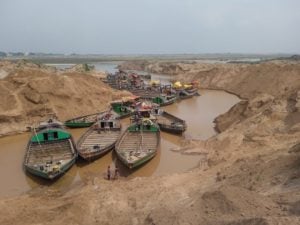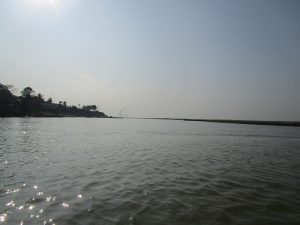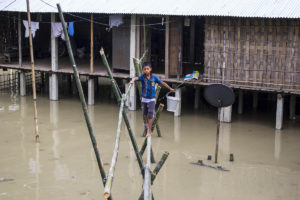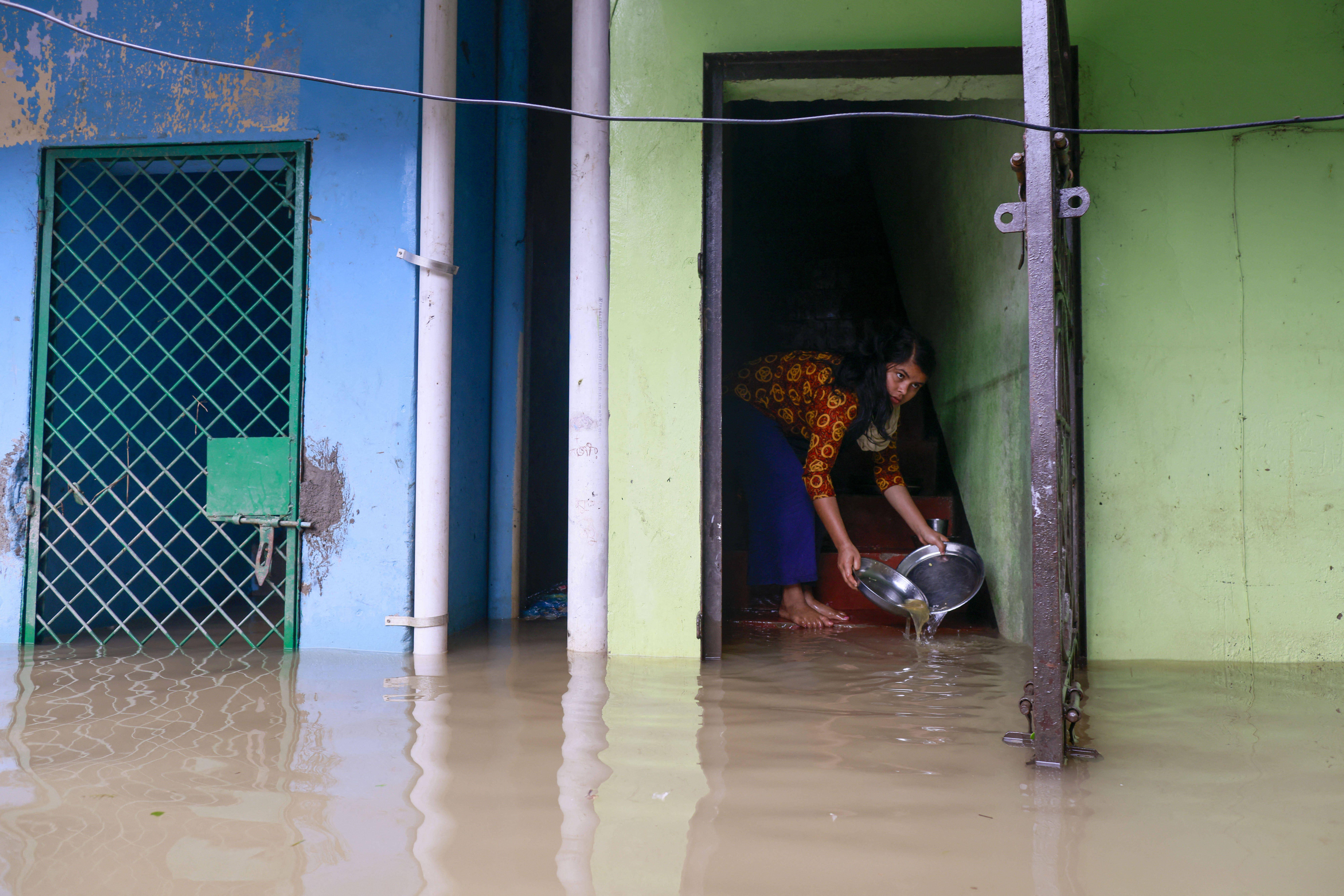
Flooding in the district of Sylhet, Bangladesh, in June 2022. Urban flooding after heavy rainfall is common, as conventional drains can quickly become clogged with silt. To combat this, engineers are using new materials in drainage systems. (Image: Suvra Kanti Das / Alamy)
Over a short period in May and June, intense rains lashed Assam, in northeastern India, and Bangladesh. As well as landslides, several rivers in the Ganga-Brahmaputra basin burst their banks. The swiftness with which floodwaters submerged towns and villages caught residents and officials off-guard.
Scientists say the problem will only increase as the impacts of climate change grow. After analysing 35 years of flooding data, a 2018 research paper concluded that rivers in the Ganga-Brahmaputra-Meghna delta will rise above dangerous levels more often in the future, as rainfall becomes more unpredictable due to higher global temperatures.
AKM Saiful Islam, a professor at the Institute of Water and Flood Management in the Bangladesh University of Engineering and Technology and an author of the study, told The Third Pole that if the world warms by 2 degrees Celsius by 2100, flooding is projected to increase by 24% and 38% in the Brahmaputra and Meghna basins respectively. The world is currently on course to warm by 2.7C by the end of the century.
Given the problem will likely only grow, scientists, engineers and urban planners are developing new technologies that can help countries adapt. Here are some of the flood solutions being rolled out.
1. Drainage systems that don’t clog up
To reduce urban flooding during heavy rainfall, it is important to quickly move water away from built-up areas. Open drains on the edge of pavements often become clogged with silt during the rainy season, resulting in water spilling over roads. Conventional drains have a layer of gravel and sand behind the retaining walls, which filters silt from surface water runoff. However, fine particles can still get through this layer of aggregate and cause drainage problems.
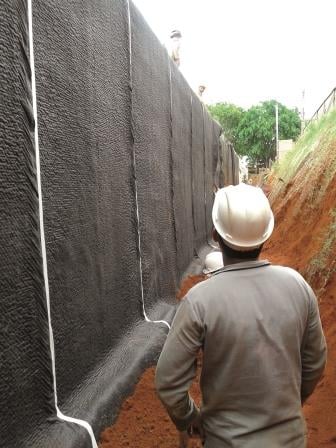
An alternative to gravel and sand is ‘drainage geocomposites’. Multinational engineering company Maccaferri has developed a drainage geocomposite, made of fine sheets of plastic around a plastic drainage core. This is fitted to a drain’s retaining walls.
Maccaferri’s MacDrain geocomposites let water through but are too fine to let silt seep through the retaining walls, keeping drains running clear and stabilising the soil, said Ratnakar Mahajan, technical manager at Maccafferi India. They also need less space, he added, explaining that “in traditional drains, you need 2- to 3-foot-wide gravel to put behind the retaining walls as filters. With geocomposites like MacDrain, the size of the filter is just one-hundredth of a millimetre”.
Mahajan said that MacDrain geocomposites cost 30-50% less than gravel to install and are more environmentally friendly “when the otherwise excavation, mining and transportation of gravel or sand as filters is taken into account”. The technology has been given an Environmental Product Declaration assessing its impact over its entire life cycle and a number of other certifications from construction and engineering associations, he pointed out.
But sewerage systems in major cities like Sylhet in northeastern Bangladesh are choked with more than just silt: plastics and other solid waste block drains and waterways, pointed out Mohamed Khalequzzaman, a professor at the Department of Geology and Physics and Geological Sciences at Lock Haven University in the US. Managing floods requires more than just desilting, with such drainage geocomposites acting as “silt socks”, Khalequzzaman said.
Then there is the question of microplastics potentially being released into the environment by the technology – given the textiles and drainage core are made from plastic. “There is very little chance of these geotextile sheets causing microplastic pollution,” said Maccaferri’s Mahajan. He explains that “once embedded in soil, their exposure in the environment is restricted”, as unless they are exposed to sunlight they do not degrade, claiming the technology should last for 100 years.
Arup Kumar Sarma, professor of civil engineering at IIT Guwahati, said: “Generally, good-quality geosynthetics are resistant to [most corrosive materials] with minimal chances of biodegradation.” However, he added, “depending on required strength, use of natural materials like coir or jute mattresses is preferred” to avoid any potential microplastic pollution.
So far, Mahajan said, the Indian government has been the main buyer of this technology, which has been used in the retaining walls of the National Highway 8 connecting Delhi to Jaipur, canal linings by the Haryana government and is in talks to be used by Indian Railways in Haflong. He said that currently the company lacks the manpower needed for installations on a large scale.
2. Hold slopes together with grasses
In Assam’s hilly regions, the annual deluge of rainfall triggers landslides. Hydroseeding is a technology that can be used to mitigate such disasters. It involves spraying a slurry of seed, mulch, fertiliser and bonding agents onto the ground, where they germinate quickly. The roots of the vegetation reduce the risk of landslides because their roots hold topsoil together.
Similarly, vetiver grass technology can be used to prevent erosion. It was first developed by bioengineers for the World Bank in India in the 1980s, when they learned that vetiver grass forms a horizontal mat of roots that can grow 2-4 metres below ground level, binding the soil together. This can reduce soil erosion by up to 90% and rainwater runoff by up to 70%.
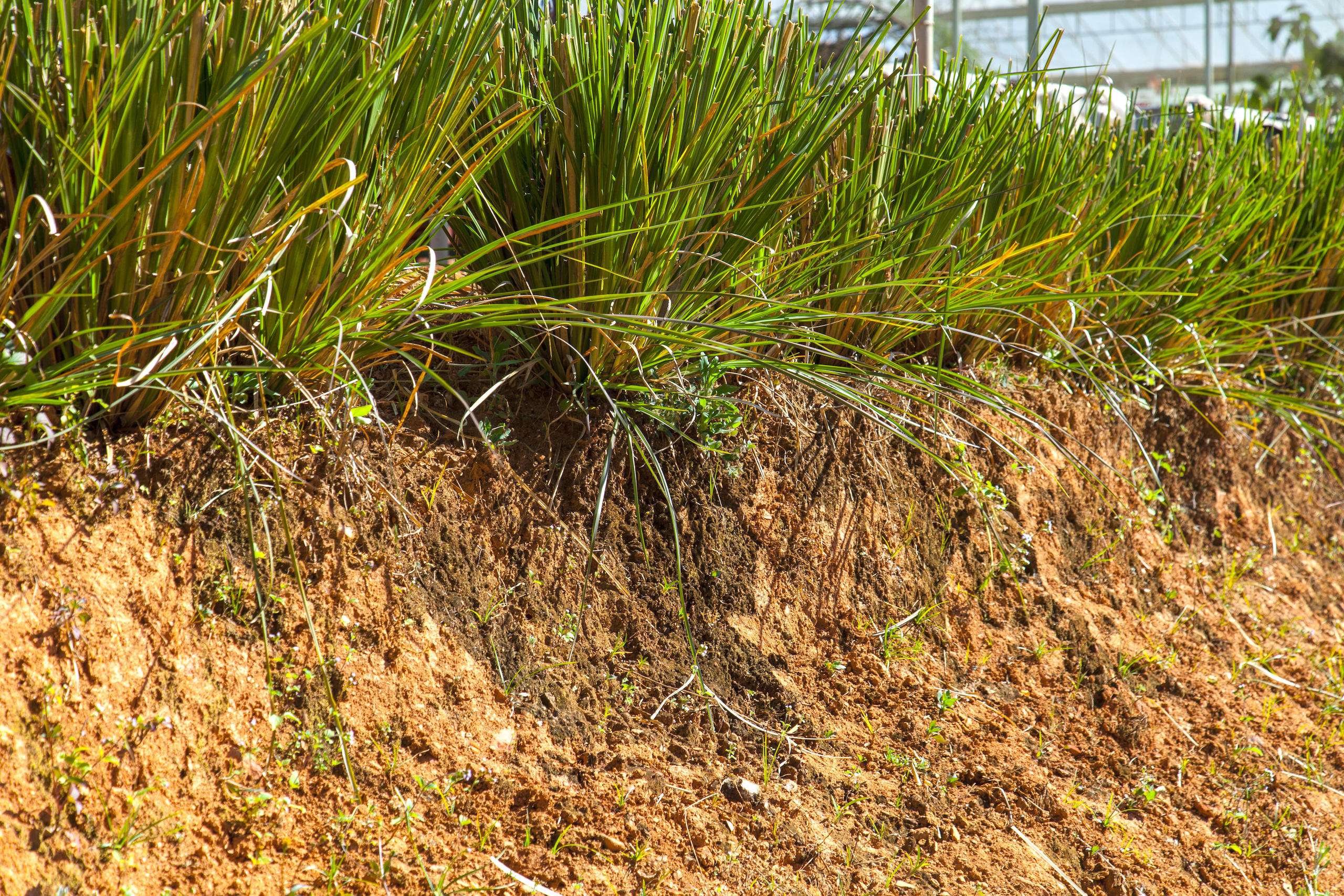
“Vetiver grass technology happens to work for a small area as it involves manual work, and hydroseeding fares well for larger areas as the slurry mix can be sprayed into an area using pumping machines that may cover the whole hill slope,” said Mahajan of Maccaferri India, which offers hydroseeding as part of its portfolio of flood-prevention products.
Introducing a new species of plant comes with risks for the environment, particularly if it has the capacity to become invasive. Rajkamal Goswami, a conservation scientist at the Ashoka Trust for Research in Ecology and Environment (ATREE), said vetiver grass is not invasive as it doesn’t outcompete native plants for resources or space. He agreed that vetiver grass can contain riverbank erosion and help stabilise slopes.
3. Increase resistance to riverbank erosion
“The current rickety embankments can be reinforced using geotextiles or geobags, which are expensive, but the issue with flood-management measures is that they are largely embankment-based,” said Partha Jyoti Das, head of the water, climate and hazards division at Aaranyak, a conservation NGO in Guwahati. Conventionally, measures to hold back overflowing river water and control erosion have involved placing rocks, sandbags or retaining walls made of concrete around hard infrastructure, such as embankments.
Instead, Das recommended, the focus should be on non-structural measures that stabilise slopes and maximise water catchment areas.
To prevent riverbank erosion, Mahajan of Maccaferri India suggested combining ‘geomats’ with hydroseeding. Maccaferri’s MacMat product, which is also made from plastic, is placed over the newly sown plants. These grow and form a 2-centimetre-thick mesh with the synthetic mat. This, Mahajan said, increases the resistance of the terrain to erosion as it slows down water, reducing the amount of soil that is washed off riverbanks.
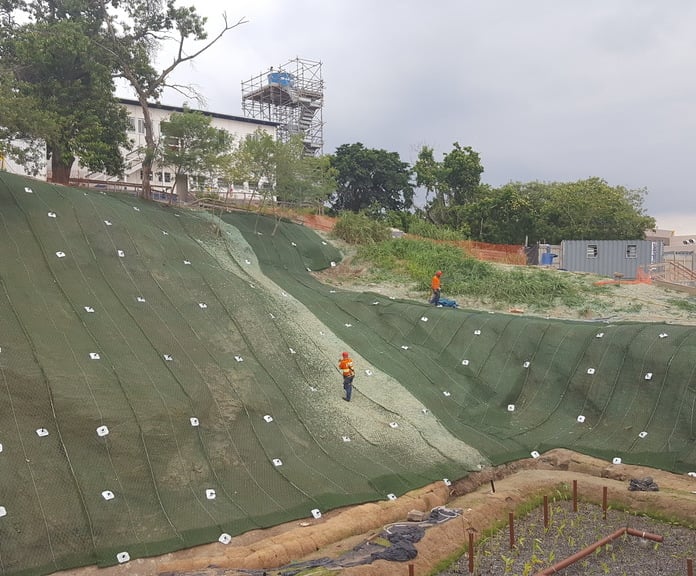
Like drainage geocomposites, geomats, geotextiles and geobags are all made from plastic. Because they filter water from soil, they allow water to move without eroding land and damaging homes and embankments, according to Maccaferri. “Any standing structure falls under the pressure of water combined with soil, so the key is to remove the water,” said Mahajan.
4. Zero-waste clean drinking water
Floodwaters stir up animal waste, sewage and other pollutants. This can contaminate drinking wells and other water sources, leading to water-borne diseases such as diarrhoea, typhoid and cholera. The only option, for those who can access it, is bottled water.
Harjeet Nath, an assistant professor in the Department of Chemical and Polymer Engineering at Tripura University has invented a suitcase-sized water purifier. Nath told The Third Pole that it can convert even contaminated wastewater into potable water that has been tested as meeting World Health Organization standards, and this year was used to help flood-affected people in Assam’s city of Silchar access drinking water. While the price of bottled water shot up from INR 20 per litre to INR 100, water from Nath’s device cost just INR 0.37.
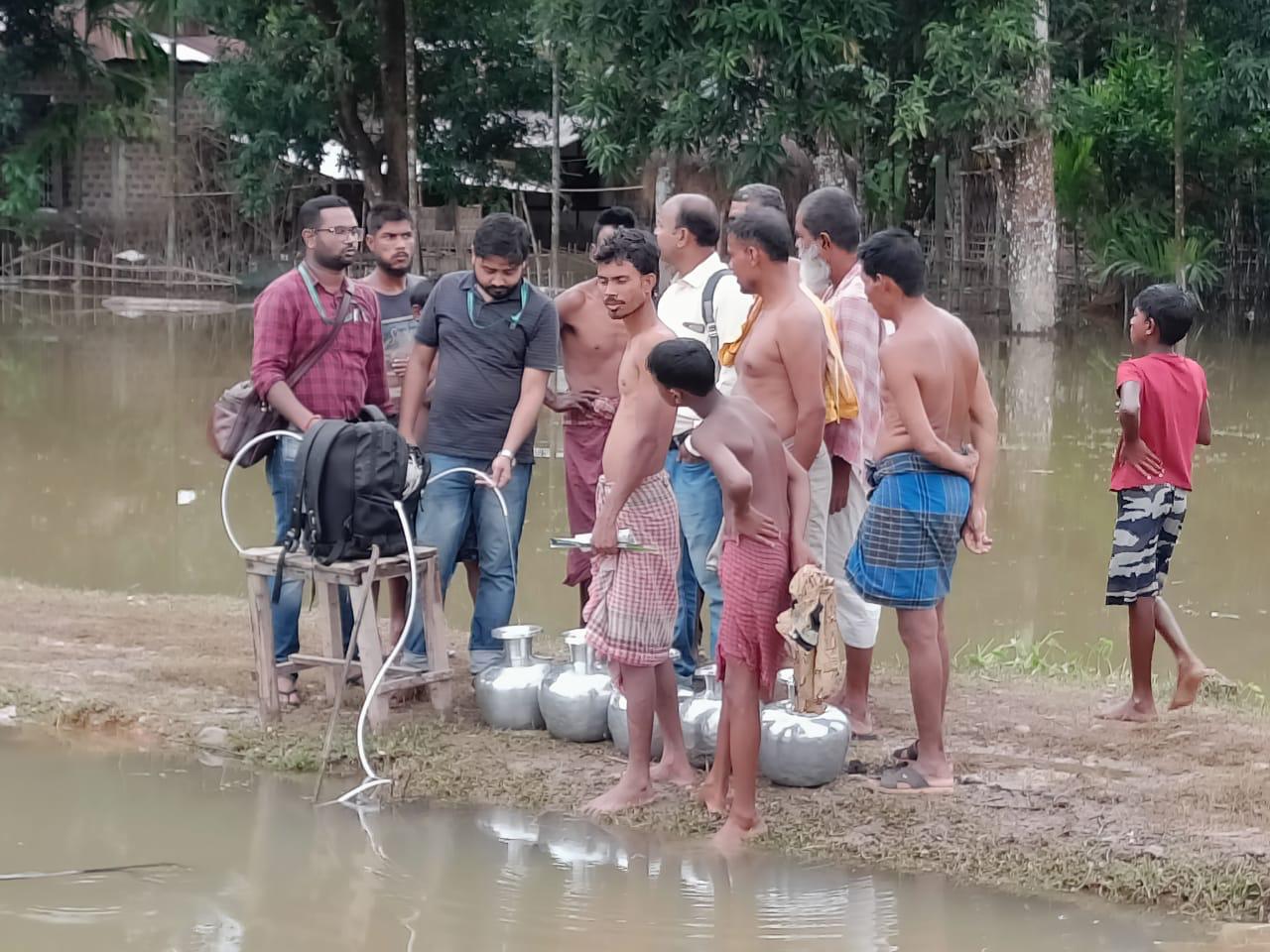
“During floods, the water purifier which works on rechargeable batteries – which can be powered by both solar and electrical energy – can work even when the power supply is usually cut off,” Nath said.
Currently there is only one machine. But Nath, who patented his technology last year, is in discussions with Indian multinational consumer goods company Eureka Forbes for its mass production.
Another low-waste way of making sure people have access to clean water during floods is sand filters in tumblers or tin containers. Since 2002, Rural Volunteer Centre, a non-profit working in disaster management, has been providing people in Assam’s Dhemaji district with these devices.
Sand filters have long been used to clean water, but the NGO modified the design with different layers of sand, mica, charcoal and cloth filters. It says this removes 100% of iron from water and 98% of pathogens. Fifty-five households have benefitted from this to date.
“Drinking water technologies should be such that they can be assembled, implemented and managed by locals as they have to confront drinking water problems during floods. Waiting for external help to arrive is excruciating,” said Eklavya Prasad, founder of Megh Pyne Abhiyan, a public charitable trust working on flood issues in eastern India.
Addressing floods at a larger scale
While technological innovations can provide mitigation and relief, they are only one part of the solution. Khalequzzaman, the professor of geological sciences at Lock Haven University, suggested that countries like India and Bangladesh should look to countries that are members of the Mekong River Commission, building consensus around solutions to floods and through dialogue and cooperation.
“Transboundary rivers do not understand political boundaries. Fifty-seven per cent of the Meghna catchment lies with India and the remaining 43% rests with Bangladesh. Without an integrated water resources pact among co-riparian countries in the Ganga-Brahmaputra-Meghna basin floods cannot be managed,” he said.
AKM Saiful Islam agreed on the need for cross-border collaboration. “When Cherrapunjee [a town in Meghalaya state] recorded over 4,000 millimetres of rainfall over three days from 15-17 June, dumping four-months’ worth of rainfall, Bangladesh’s Flood Forecasting and Warning Centre which predicts floods five days ahead couldn’t process the intensity of the rainfall in the hilly regions of India’s Meghalaya,” Islam said. He emphasised that only the sharing of rainfall and hydrological data between India and Bangladesh can really help both countries prepare for more intense flooding as climate change worsens.
Earlier this month Bangladesh and India signed a water-sharing agreement for the small transboundary Kushiyara River, but there is still no formal agreement on exchanging flood warnings for all the rivers the two countries share.


